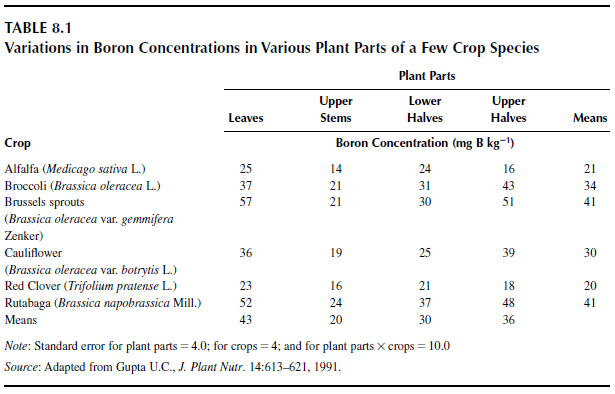Boron Concentration in Crops
Plant part and Growth stage
As extractants have not been developed fully to evaluate the availability of boron in soils, plant tissue testing continues to be the preferred means of delineating the boron deficiency and sufficiency levels in plants. It seems, therefore, desirable to sample the plant parts that contain the highest quantity of boron to characterize its status in crops. The use of plant parts containing the higher nutrient values should facilitate better differentiation between the deficiency and sufficiency levels.The part of the leaf, its position in the plant, the plant age, and the plant part are some of the factors that affect the boron composition of plants. Studies by Vlamis and Ulrich (92) showed that young blades of sugar beets contained more boron than the mature and old blades of plants grown at low concentrations of boron in a nutrient solution. However, at higher boron concentrations in solution, no differences were found. The highest boron values in sugar beets occurred in the older leaves, but the lowest boron content occurred in the fibrous and storage roots (92). The boron concentration of corn leaves increased with age in seedling leaves (104). The uppermost corn leaves had higher concentrations than did leaves at positions below. Boron concentration in corn leaves and tassels of flowering corn plants increased with age, but boron in other plant parts remained low and relatively constant (105).
Gorsline et al. (106) noted that boron concentration in the whole corn plant decreased during initial growth, remained unchanged during most of the vegetative period, and then decreased after silking.
Gupta and Cutcliffe (86) reported that boron level in leaf tissue of rutabaga was greater from early samplings than it was from late samplings. Older cucumber (Cucumis sativus L.) leaves contained more boron than the younger leaves; and within the leaf, boron accumulated in the marginal parts (107). Boron accumulation was greater in the marginal section of corn leaves than in the midrib section (108). Generally, boron in plants has a tendency to accumulate in the margin of leaves (109,110). Results of Miller and Smith (111) showed that alfalfa leaves had much higher boron content (75 to 98 mg kg-1) than tips (47 mg kg-1) or stems (22 to 27 mg kg-1). In a field study conducted in Prince Edward Island, Canada, the highest boron concentrations were in leaves and upper halves of plants of most species (Table 8.1). The boron concentrations were lowest in the stems. The lowest boron concentration was in alfalfa and the highest in Brussels sprouts and rutabaga. In a separate experiment, where the effect of not applying boron was studied against applied boron, the trend in boron accumulation in the various plant parts was similar. The boron content of pistils and stamens, although very high, was often lower than in leaves and sometimes of corollas (112).
Gupta (113) found that without added boron, the bottom third of the leaves of alfalfa and red clover contained significantly higher boron than did the upper leaves. In the case of stems the opposite was the case, i.e., the upper third of the stems contained more boron than the bottom third. This trend was similar for the unfertilized and boron-fertilized areas for leaves; however, in the presence of added boron, differences in the boron content in the upper and lower stems were not significant.
 |
The general theory is that boron translocates readily in the xylem, but once in the leaves, it becomes one of the least mobile of the micronutrients. Thus the boron immobility in leaves in terms of localized cyclic movement prevents escape and transport of this element over long distances (114). The results of Shelp (115) have also shown that younger leaves contain less boron than mature leaves; the authors assumed that the boron supply for mature leaves is delivered principally via the xylem.
The fact that boron deficiency exhibits in the younger leaves and not in the older leaves can be explained by the fact that the boron concentration is higher in the older leaves than in the younger leaves, as reported for alfalfa and red clover (113) and for broccoli (115). Since the boron concentration in the upper leaves was easily increased with boron fertilization (113), boron deficiency is controlled without much difficulty using boron applications.
It is suggested that leaves should be sampled to determine the boron status of the plants. Also, it is important to be consistent with the plant sampling technique in the field as well as the plant part sampled.




